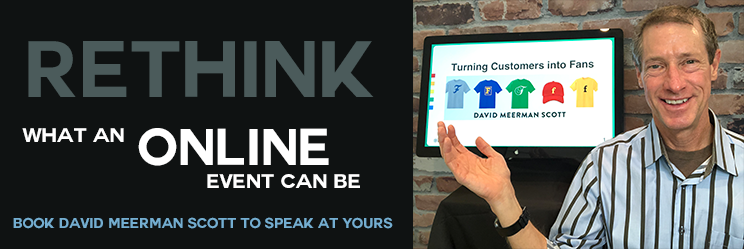Social Media | Public Speaking | Fanocracy | Virtual Events
 As companies have pivoted from in-person events to virtual events in 2020, one of the most common questions I’m asked is how to drive social media engagement. Event planners are eager for people to share but want to understand the best way to build a tribe of like-minded people. Twitter and other networks are an ideal back channel for people to communicate before, during and after a virtual event.
As companies have pivoted from in-person events to virtual events in 2020, one of the most common questions I’m asked is how to drive social media engagement. Event planners are eager for people to share but want to understand the best way to build a tribe of like-minded people. Twitter and other networks are an ideal back channel for people to communicate before, during and after a virtual event.
Virtual event social engagement basics
With Twitter, the key is choosing a unique hashtag that will aggregate all the tweets of people who use that hashtag into one feed so people can see what is happening in real-time. Many virtual event planners with good intentions choose a hashtag that is already being used by another event or for another purpose. Make sure you do a search on Twitter and other social networks for that hashtag to see if it is already being used. You want to your hashtag to be unique to your event or event series.
 Some events use the same hashtag for their in-person events year after year while others create a unique hashtag each year, typically by adding the year after the event name. Sometimes, a hashtag grows organically as people gravitate towards it so keep in mind that there may be more than one active hashtag around your event. For example, during the leadup to HubSpot’s virtual INBOUND 2020 event people who are eager to attend were using both #Inbound and #Inbound2020 hashtags. I have even seen a few people using #Inbound20.
Some events use the same hashtag for their in-person events year after year while others create a unique hashtag each year, typically by adding the year after the event name. Sometimes, a hashtag grows organically as people gravitate towards it so keep in mind that there may be more than one active hashtag around your event. For example, during the leadup to HubSpot’s virtual INBOUND 2020 event people who are eager to attend were using both #Inbound and #Inbound2020 hashtags. I have even seen a few people using #Inbound20.
Ideally, you would choose a hashtag as early as possible, preferably before you announce your event. Then, mention the hashtag in all your communications as you launch your virtual event, on the event website, and in all your social media posts, and emails to attendees. Ask speakers, sponsors, and affiliates to all use the hashtag as they announce their participation.
During the event, it is a good idea to have somebody on your team monitor social media and share posts on the social networks, ensuring that each one includes the hashtag.
How IMPACT drives interaction at their virtual events
“I’ve always been a big fan of hashtags at live events and it turns out virtual events are no different,” says Stephanie Baiocchi, the director of community and events at IMPACT, a company is focused on empowering digital sales and marketing professionals and business leaders with the education, tools, training, and support needed to grow their companies and careers. “Hashtags, especially on Twitter and Instagram, are a way for attendees to connect and share how they’re experiencing the event in a way that most virtual event platforms just aren’t capable of doing. The stream of posts on an event’s hashtag becomes sort of a virtual hallway where people can chat between sessions and share things they’ve learned with others. It’s a bit more casual and organic than saying something in the chat section of a session.”
In mid-March 2020, Stephanie and the team at IMPACT made the call to postpone their in-person event, Digital Sales & Marketing World, which was scheduled for April 6th. They had so much great content that they did not want to wait to share it with their audience, nor did they want to leave them hanging. Instead, they decided to host a one-day virtual event instead.
 “In about three weeks we managed to pull together this entire virtual event which ended up drawing over 3,000 registrants,” Stephanie says. “Granted, we already had most of the speakers lined up which was a huge part of why we were able to turn it around this quickly. However, there was still a lot to do in those few weeks. We had to find a platform and build out our entire event, test everything, and get all the necessary links to join into the virtual hands of our attendees.”
“In about three weeks we managed to pull together this entire virtual event which ended up drawing over 3,000 registrants,” Stephanie says. “Granted, we already had most of the speakers lined up which was a huge part of why we were able to turn it around this quickly. However, there was still a lot to do in those few weeks. We had to find a platform and build out our entire event, test everything, and get all the necessary links to join into the virtual hands of our attendees.”
The one-day virtual event, Digital Sales & Marketing Day, was a huge success for IMPACT, so much so that they did it again less than two months later with all new content. Soon they developed an ongoing program of virtual events.
“IMPACT’s virtual events brought our audience together in a time of crushing isolation of quarantine,” says Stephanie. “Through our virtual events we were able to help businesses focus on the right things to weather the storm of the pandemic as much as possible and empower digital sales and marketing professionals to better connect, build trust, and sell virtually.”
I was a speaker at IMPACT’s April 6 Digital Sales & Marketing Day. Like all sessions that day, my talk was prerecorded which allowed me to participate in the chat, live, as the recorded talk was playing. I answered questions, provided color commentary and connected personally with some audience members who had specific questions. I also interacted on Twitter.
“To me, part of the magic of in-person events was always the human connection,” Stephanie says. “I know people feared losing this in the virtual space but if we have the technology available to connect with other attendees in real time just like at an in-person event and hashtags are a huge part of making that happen.”
Another specific benefit of using a social media hashtag for event organizers is the ability to get a real-time pulse on how attendees feel about your event. “On the day of Digital Sales & Marketing Day, our first virtual event, I was a nervous wreck,” Stephanie says. “Between troubleshooting technical issues, managing a team responding to attendee questions, and co-hosting a live session, I felt like I had stepped outside of my body and was watching myself navigate this new virtual experience. However, a quick look at #DSMD2020 on Twitter showed me we were doing things right. Attendees were posting photos of their laptops shouting out the speakers they were enjoying. Some posted photos of dogs or cats next to their computers as they attended the event. But probably most satisfying was seeing our speakers connect with attendees just like they would at an in-person event and even seeing attendees connect with each other.”
Stephanie actively encourages attendees to share their experience on social media during the event. She is like a warm homeroom teacher putting the unruly kids into virtual groups and encouraging them to use their words to share what they are thinking. “I ask questions to get people to open up,” she says. “Are you watching this while you make soup? Send me a picture on Twitter (and possibly the recipe too)! Is your kid right next to you e-learning and this is an opportunity for you to show them that you’re a lifelong learner? I’d love to see that photo, plus you can connect with other parents attending the event who are also balancing work and parenting and e-learning.”
The IMPACT virtual event program has benefited the company in several important ways. The events allow them to continue their mission of educating their audience and empowering them to grow their businesses. Teaching through virtual events allows them to build trust with attendees which Stephanie says definitely leads to some of them wanting to work with the company and use their services. Importantly, the virtual event programs have generated revenue which Stephanie says has seriously helped their business during this challenging time.
Perhaps best of all for IMPACT is they have built a Fanocracy. Attendees at their virtual events are sharing and engaging and eager to participate in the next one. They are not just past or present attendees. They are fans of the company.
This blog post was adapted from my book co-written with Michelle Manafy Standout Virtual Events: How to create an experience that your audience will love.




